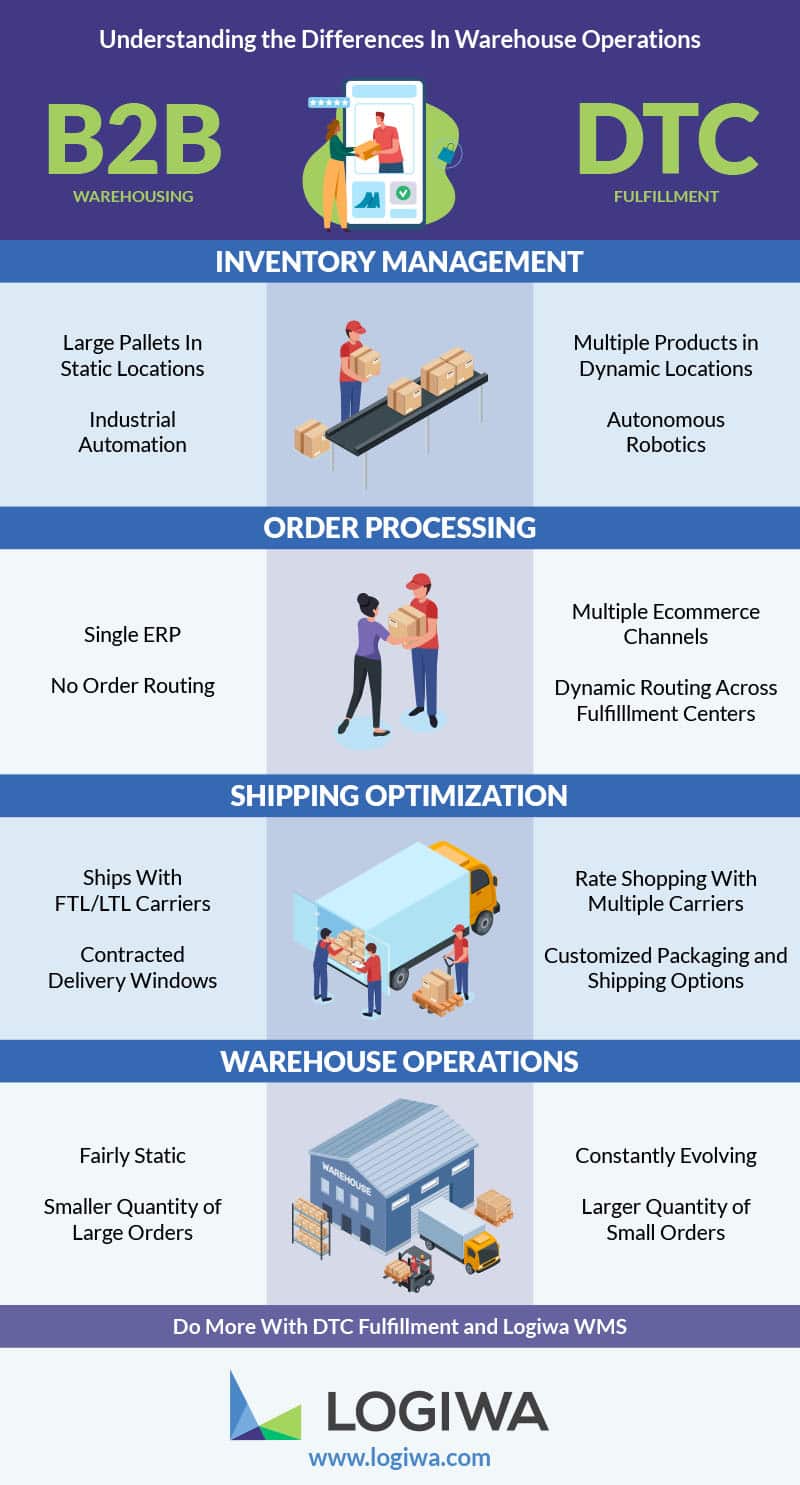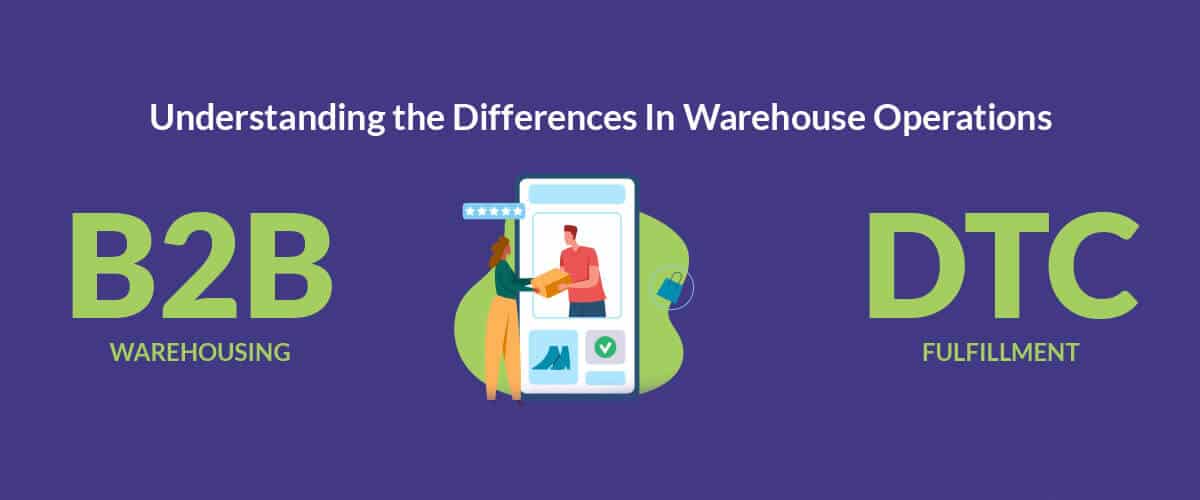COVID-19 was the rocket that fueled unprecedented growth in ecommerce. Even brands that were slow or resistant to adopt ecommerce as a business model had to respond to their customers’ demand to shop and purchase online. The expectations set during the pandemic are here to stay, and the need for improved ecommerce fulfillment operations are growing right along with it.
A trend we at Logiwa are increasingly seeing with our customers is the need to maximize the value of their investment in warehouse space and adopt a hybrid format capable of handling both B2B and direct-to-consumer (DTC) fulfillment.
But for warehouses that have traditionally operated in a B2B fulfillment model, this transition poses unique challenges. B2B fulfillment organizations realize that in order to scale to the level that DTC fulfillment requires, they need to understand the distinct differences in warehouse operations. While it may seem simple enough to add more SKUs to your existing warehouse structure, there are many nuances between B2B and DTC fulfillment that need to be addressed.
Contents
Key Takeaways
- To remain competitive in today’s evolving consumer market, traditional B2B operations are expanding their operations to include direct-to-consumer (DTC) fulfillment.
- While B2B facilities use large pallets, static locations and industrial automation to fulfill small quantities of large orders, DTC requires facilities to adapt to manage large quantities of small orders (e.g. dynamic storage locations, autonomous picking robots, etc.).
- Unlike B2B operations, which can rely on a single ERP, DTC fulfillment requires solutions which can integrate with multiple ecommerce channels and route orders across multiple fulfillment centers.
- B2B warehousing ships with FTL/LTL carriers and contracted delivery windows, while DTC necessitates rate shopping, the use of multiple carriers and custom packing and shipping options.
- Modern WMS solutions like Logiwa WMS make it easy to manage and optimize B2B and DTC hybrid operations by leveraging cloud visibility, leading integration technology, smart automation and more.
Understanding the Differences In Warehouse Operations

To download this infographic – CLICK HERE
With more than half of today’s consumers preferring to shop online rather than in brick and mortar stores, traditional B2B fulfillment networks want to expand their operations to include DTC fulfillment. But as you can see from the infographic above, there are lots of differences to consider.
Comparing B2B Warehousing with DTC Fulfillment
We’ve identified four main areas where B2B warehousing differs from DTC fulfillment. To successfully prepare for the shift to hybrid warehousing it is important to understand these differences.
Inventory Management
- B2B warehousing uses large pallets in static locations and relies on industrial automation
- DTC fulfillment houses multiple products stored in dynamic locations and makes use of autonomous robotics
Order Processing
- B2B often rely on a single ERP and rarely requires order routing
- DTC requires multiple ecommerce channels and may need dynamic routing across multiple fulfillment centers
Shipping Optimization
- B2B warehousing ships with FTL/LTL carriers and takes advantage of contracted delivery windows
- DTC fulfillment requires rate shopping with multiple carriers and customized packing and shipping options
Warehouse Operations
- B2B warehousing is fairly static and moves small quantities of large orders
- DTC fulfillment is constantly evolving and handles large quantities of small orders
From inventory management to shipping optimization, these differences span the entire warehouse and can upend a business that isn’t prepared with the right systems and WMS software in place. Logiwa’s deep domain and technical expertise was instrumental in developing a solution with those differences in mind and from the beginning was designed to handle high-volume DTC fulfillment easily and seamlessly.
Doing More with DTC Fulfillment
DTC fulfillment is intense. Putaway, picking, and packing of multiple products for a high volume of small orders requires very different operational processes from the pallet shipping typical in B2B environments. You may need integration with robotics or other solutions in the fulfillment ecosystem, or the ability to route orders to different fulfillment centers. You may need to upgrade your technology to take advantage of the power of the cloud, including artificial intelligence (AI) and machine learning, or you may need to leverage more insights from your operational data to make better, faster and more profitable decisions. And you’ll certainly need to be connected to a variety of ecommerce channels.
Logiwa was purpose-built with these requirements in mind, so you’ll be able to expand your DTC fulfillment operations with ease. What’s more—getting started with Logiwa is fast. With pre-built integrations to most leading ecommerce platforms, carriers, accounting, ERP, and robotics systems you can be up and running in weeks, saving significant time and cost associated with traditional WMS implementations.
If you are thinking of adding or expanding DTC fulfillment in your existing warehouse Logiwa can help. Our sales and onboarding engineers have years of warehouse experience. And we have a network of consultants who specialize in modern warehouse fulfillment operations. Request our DTC fulfillment playbook for more insights on building hybrid operations with a free demo or contact our team today.
Unlock a personalized tour of Logiwa IO
FAQs Related to Hybrid B2B and DTC Fulfillment
What is hybrid B2B and DTC fulfillment?
Hybrid B2B and DTC fulfillment is a business model that incorporates both business-to-business and direct-to-consumer fulfillment operations. In addition to processing and shipping small quantities of large, bulk orders to other businesses, hybrid operations manage fulfillment for a large number of small orders to individual consumers.
Why become a hybrid fulfillment model?
As ecommerce has grown, online shopping has become the preferred purchasing method for many of today’s consumers. In order to remain competitive and adapt effectively to DTC market trends, traditional B2B warehouses must offer DTC fulfillment options. Doing so helps hybrid operations scale, retain clients and increase profits long-term.
How do operations manage hybrid fulfillment models?
The next generation of fulfillment solutions help businesses build out successful, multi-location fulfillment networks capable of handling both B2B and DTC operations. With cloud accessibility, robust integrations, smart automation and other AI-powered tools, leading WMS platforms are able to optimize visibility and control over day-to-day fulfillment processes: from order processing and inventory management to shipping and return logistics.





